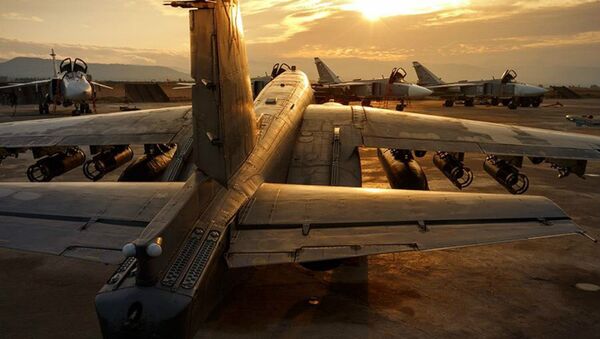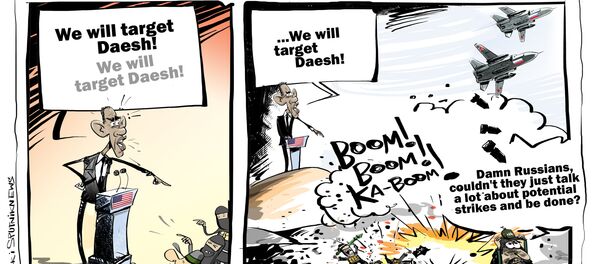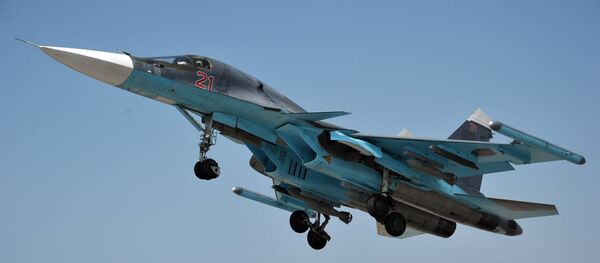On September 30, 2015, responding to a formal request from Syrian President Bashar Assad, Russian President Vladimir Putin agreed to use Russia's armed forces in Syria, having first received approval from Russia's Federation Council (Russia's Senate).
Earlier that week, Putin concisely laid out the problems facing Syria and the broader Middle East at the United Nations, in what has since been dubbed his 'Do you realize what you have done?' speech.
On September 30, pilots from Russia's air force – the Aerospace Defense Forces, began precision air strikes on Daesh (ISIL/ISIS) targets. Syria provided Russia with the use of the Hmeymim Air Base in northwest Syria for the operation. Armed with a few dozen planes and helicopters, the base was reinforced with a battalion of naval infantry, along with strike ships and support vessels off the Syrian coast.
October: 1,391 Strikes, Destruction of 1,080 Terrorist Oil Tankers and 1,623 Terrorist Targets
The month of October started off with a bang, with repercussions not just for the Russian anti-terrorist operation, but military analysts' assessment of Russia's military capabilities as a whole. On October 7, small missile ships from Russia's Caspian Flotilla launched 26 Kalibr-class cruise missiles at targets in Syria. The missiles traveled over 1,500 km across Iranian and Iraqi airspace to reach their targets.
Beforehand, Russian, Iraqi, Iranian and Syrian officials established an information center in Baghdad to coordinate the anti-terror fight. Also in October, the Russian Defense Ministry and the US Department of Defense signed a memorandum aimed at ensuring the safety of Russian aircraft and those of the US-led anti-terrorist coalition, which had been bombing Daesh positions in Iraq and Syria since September 2014.
November: Retribution for the Daesh Attack on a Russian Passenger Airliner Over Egypt
In November, the Russian Federal Security Service confirmed that Daesh was behind the destruction of Metrojet Flight 9268, a passenger airliner filled with Russian tourists that went down over the Sinai Peninsula on October 31, 2015, killing all 217 passengers and crew on board. In response, President Putin demanded that the military step up their attacks against Daesh.
With the Caspian Flotilla launching another 18 cruise missiles at terrorist targets across Syria, long-range aviation was also used for the first time, with Tu-160, Tu-95MS and Tu-22M3 strategic bombers joining the operation from airfields inside Russia.
"Our air forces' work in Syria must not simply be continued. It must be intensified in such a way that the criminals understand that retribution is inevitable," Putin emphasized, after paying tribute to the victims of the attack on the airliner.
Putin called the Turkish betrayal a 'stab in the back', cutting diplomatic contacts, introducing sanctions on Turkish produce and halting tourism ties. Relations between the two countries were normalized only a year later, after Turkish authorities issued a formal apology to the family of the deceased pilot.
In the meantime, immediately after the incident, Russia deployed its advanced S-400 Triumf surface-to-air missile system at Latakia, and equipped fighters with air-to-air missiles.
December: Kilo-Class Sub Barrages Daesh Targets With Kalibrs
On December 8, as Russian air power continued its operation to pummel terrorist targets, a Russian Kilo-class attack sub Rostov-on-Don joined in the fight, launching Kalibr cruise missiles at Daesh from the Mediterranean Sea.
January: 100 Days = 1.5 Times the Damage to Daesh That the US-Led Coalition Managed to Cause
In January, the Russian military marked 100 days since the start of its operation in Syria. Stepping back to assess the damage caused to the terrorists, Russian officials calculated that in just over three months, Russian aircraft and ships had hit the terrorists with 1.5 times more missile and bomb strikes than the US led coalition had in a year. At the same time, analysts calculated that while the US was then spending an average of $11.4 million a day on its anti-Daesh operations, Russia spent only $2.5 million.
Late Winter/Spring Surprise: Putin Calls for Cessation of Hostilities
In February, Vladimir Putin made an appeal to halt the fighting between Syrian Army forces and the US and Gulf State-supported 'moderate rebels'. A ceasefire was agreed on February 22, stepping into force on February 27 and applicable to all forces except Daesh, Nusra, and other groups listed as terrorists by the UN.
The ceasefire resulted in a severe drawdown of Russian operations in the country, with Moscow even ordering the Ministry of Defense to begin to withdraw Russian forces starting in mid-March. Journalists soon remembered that the Russian president had hinted at such an eventuality in advance. In October, shortly after the start of the operation, Putin had stated that Russia's task was "to stabilize the legitimate government and establish conditions…for political compromise." With the Syrian ceasefire, that process seemed to have begun.
On March 17, Alexander Prokhorenko, a Russian Spetsnaz officer tasked with locating targets for airstrikes in the Palmyra area, was killed after ordering an airstrike on his position when he realized he was surrounded by Daesh forces. For this feat he was posthumously awarded the title Hero of Russia.
Two weeks later, the Syrian Army and allied militia, supported by Russian airpower, completely liberated Palmyra, which had been captured by Daesh in May 2015. In April, Russian sappers were then sent to the UNESCO World Heritage site to defuse nearly 19,000 mines, booby-traps and IEDs. In this way, Russia not only played an important role in helping to save the priceless artifacts from being further defiled, but in cutting off Daesh's profits from the sale of antiquities to black market dealers.
Scorching Summer: Aerospace Defense Forces Deliver Aid, Continue Pinpoint Attacks
In May, Evgeny Lukyanov, deputy secretary of the Russian Security Council, summed up the state of the Russian operation, calculating that of the estimated 80,000 militants in Daesh and al-Nusra's ranks, 28,000 (35%) had been killed by the Syrian Army and Russian air attacks since September, with the US-led coalition eliminating another 5,000 over the previous two years.
The late spring and early summer were filled with rumors that Saudi Arabia and/or Turkey were on the verge of intervening in the conflict. Accordingly, Russian forces maintained their presence in Syria, launching selective attacks, most actively in the northern region of Aleppo, where Syrian forces eventually succeeded in surrounding the terrorist-held portions of the city of Aleppo, Syria's second city.
In late July, Syria and Russia launched a massive humanitarian operation in the city, including humanitarian corridors meant for the evacuation of civilians, and a special one for militants wishing to leave the city. Russian and Syrian forces paradropped and drove in food, medicine, and other essentials to civilians in the militant-held portions of the city.
In August, the Russian Black Sea Fleet joined the operation, launching missile strikes on al-Nusra (which renamed itself Jabhat Fateh al-Sham).
Meanwhile, aircraft were deployed to Iran's Hamadan Airbase to hit Daesh positions in Deir ez-Zor, a city which has been besieged by the terrorists for over two years. Finally, Turkish forces entered northern Syria, ostensibly for an operation to liberate the Daesh-controlled city of Jarabulus from the terrorists. Syria and Russia signed an agreement to make the deployment of Russian air power in Latakia permanent.
September: Ceasefire Hangs in the Balance
Just prior to its one year anniversary, analysts summarized that the Russian military operation in Syria. Aerospace Defense Forces jets, bombers and helicopters flew over 15,000 combat missions, destroying thousands of enemy strongpoints and assets, and killing nearly 30,000 militants, including 2,000 terrorists with Russian passports, 17 commanders among them.
Unfortunately, the Russian military has also paid a heavy human cost. 20 servicemen lost their lives – including five who died in an attack on Mi-8 military transport helicopter in August.
Stepping into force on September 12, the ceasefire held for about a week before the Syrian government withdrew, citing over 300 violations by US-supported moderate rebels, and a reprehensible 'mistaken' attack by the US-led coalition on Syrian Army positions in Deir ez-Zor, which killed over 60 Syrian servicemen and injured 100 more.
One year on, tens of thousands of terrorists have been killed, hundreds of towns and settlements have been liberated, the militants in Aleppo have been surrounded, and Daesh's territory, finances and strength is quickly dwindling. The question now is whether the diplomatic solution Russia has been pressing for all along can succeed. But that's up to the diplomats. The military has done its job.







